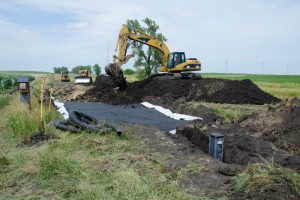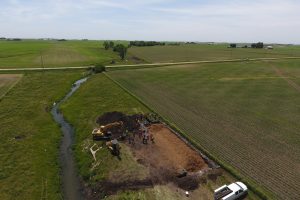Bioreactor: Redirects tile water to an underground bed of wood chips where nitrate is removed naturally by microorganisms. Vegetation on top of the bioreactor can provide other benefits such as wildlife habitat.
Resources
Short Article
Bioreactor — Underground Filtration to Reduce Nitrate Concentrations and Improve Water Quality
A bioreactor is an edge-of-field treatment process that allows producers to reduce the amount of nitrate leaving the field from a tile line and therefore improve the water quality of the receiving stream. A bioreactor consists of a buried pit filled with a carbon source — such as wood chips — through which tile water is diverted. The carbon provides a food source for microorganisms that use the nitrate to metabolize the carbon, converting the nitrate to harmless atmospheric nitrogen (N2) gas.
The Benefits
In addition to improved fertilizer management, tillage management, and wetland restoration, bioreactors help improve water quality by reducing nitrate-nitrogen that naturally occurs in agricultural drainage. They can reduce nitrate by an average of 43 percent. Bioreactors have proven to work well in existing filter strips and can be placed in other locations.
What’s Next
The Iowa Nutrient Reduction Strategy lays out a scenario in which 120,000 – 130,000 edge-of-field practices such as bioreactors and saturated buffers are needed to reach the 41 percent nitrogen reduction goal. Want to be part of the solution? Contact your local Soil and Water Conservation District office to learn more about bioreactors for your farm.
Longer article – technical
A bioreactor is an edge-of-field treatment process that allows a producer to reduce the amount of nitrate leaving the field from a tile line and therefore improve water quality of the receiving stream. A bioreactor consists of a buried pit filled with a carbon source — such as wood chips — through which tile water is diverted. The carbon provides a food source for microorganisms that use the nitrate to metabolize the carbon, converting the nitrate to harmless atmospheric nitrogen (N2) gas.
In addition to improved fertilizer management, tillage management, and wetland restoration, bioreactors help improve water quality by reducing nitrate-nitrogen that naturally occurs in agricultural drainage. They can reduce nitrate by an average of 43 percent. Bioreactors have proven to work well in existing filter strips and can be placed in other locations.
Bioreactors offer a relatively high rate of nitrate removal with a small footprint on the landscape. They require very little maintenance during their lifecycle and a number of programs are available to offset much of the cost.
The Iowa Nutrient Reduction Strategy lays out a scenario in which 120,000 – 130,000 edge-of-field practices such as bioreactors and saturated buffers are needed to reach the 41 percent nitrogen reduction goal. Want to be part of the solution? Contact your local Soil and Water Conservation District office to learn more about bioreactors for your farm.
Social Media Posts
#Bioreactors are a good way to help support #waterquality in Iowa. While they may sound complicated, they actually have a small footprint on your land.
We’re hosting a #bioreactor field day. Farmer-to-farmer learning is key with new practices to improve #waterquality. Join us (add date and location details)!
Bioreactors improve #waterquality through natural processes. Learn more about this low-cost, low-maintenance option! https://www.iowaagwateralliance.com/bioreactors/
Facebook Post
Bioreactors are an underground bed of wood chips that improve water quality by reducing nitrate concentrations. Learn more about this low-cost, low-maintenance option for your farm! https://www.iowaagwateralliance.com/bioreactors/



